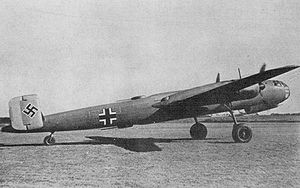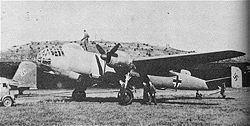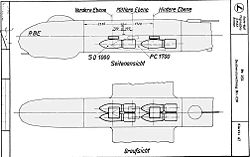Focke-Wulf Fw 191 Video - Picture

|
|
Focke-Wulf Fw 191

Picture - Although it was considered a failure, it provided technological insight.
Role: Advanced Medium Bomber
National origin: Germany
Manufacturer: Focke-Wulf Flugzeugbau
First flight: Early 1942
Status: Prototype
Primary user: Luftwaffe was planned user.
Number built: 3
Program cost: N/A
Unit cost: N/A
The Focke-Wulf Fw 191 was a prototype German bomber of World War II. Two versions were intended to be produced, a twin-engine version using the Junkers Jumo 222 engine and a four-engine variant which was to have used the smaller Daimler-Benz DB 605 engine. The project was eventually abandoned due to technical difficulties with the engines.
Design and development
In July 1939, the RLM issued a specification for a high-performance medium bomber (the "Bomber B" program). It was to have a maximum speed of 600 km/h (370 mph) and be able to carry a bomb load of 4,000 kg (8,820 lb) to any part of Britain from bases in France or Norway. Furthermore, the new bomber was to have a pressurized crew compartment, remotely-controlled armament and was to utilize two of the new 1,864 kW (2,500 hp) class of engines then being developed (Jumo 222 or Daimler Benz DB 604). Arado, Dornier, Focke-Wulf and Junkers participated in. The Arado Ar E340 was eliminated. The Dornier Do 317 was put on a low-priority development contract; and the Junkers Ju 288 and Focke Wulf Fw 191 were chosen for full development.
Dipl. Ing E. Kx¶sel, who also worked on the Fw 189 reconnaissance plane, was supposed to have led the design team for the Fw 191. Overall, the Fw 191 was a clean, all-metal aircraft that featured a shoulder-mounted wing. Two 24-cylinder Jumo 222 engines (which showed more promise than the DB 604 engines) were mounted in nacelles on the wings. An interesting feature was the inclusion of the Multhopp-Klappe, an ingenious form of combined landing flap and dive brake, which was developed by Hans Multhopp. The entire fuel supply was carried in five tanks located above the internal bomb bay, and in two tanks in the wing between the engine nacelles and fuselage.
The tail section was of a twin fins and rudders design, with the tailplane having a small amount of dihedral. The main landing gear legs retracted to the rear and rotated 90° to lie flat in each engine nacelle, much like the main gear on the production versions of the Ju 88 already did. Also, the tailwheel retracted forwards into the fuselage. A crew of four sat in the pressurized cockpit, and a large Plexiglas dome was provided for the navigator; the radio operator could also use this dome to aim the remotely-controlled rear guns.

Picture - Focke-Wulf Fw 191 Front View
The Fw 191 followed established Luftwaffe practice in concentrating the crew in the nose compartment, and in the use of a "stepless cockpit", having no separate windscreen for the pilot, as the later -P and -H versions of the Heinkel He 111 already did. This was pressurised for high-altitude operations. The proposed operational armament consisted of one 20 mm MG 151 cannon in a chin turret, twin 20 mm MG 151 in a remotely controlled dorsal turret, twin 20 mm MG 151 in a remotely-controlled ventral turret, a tail turret with one or two machine guns and remotely-controlled weapons in the rear of the engine nacelles. However, different combinations were mounted in the prototype aircraft. Sighting stations were provided above and below the crew compartment.
The aircraft had an internal bomb bay. In addition, bombs or torpedoes could be carried on external racks between the fuselage and the engine nacelles. The design was to have had a maximum speed of 600 km/h (370 mph), a bomb load of 4,000 kg (8,820 lb), and a range allowing it to bomb any target in Britain from bases in France and Norway.
Failure and End of Program

Picture - Focke-Wulf Fw 191 Side View
It is said that the installation of so many electric motors and wiring led to the nickname for the Fw 191 of "Das fliegende Kraftwerk" (the flying powerstation). This also had the detrimental effect of adding even more weight to the overburdened airframe, plus there was also the danger of a single enemy bullet putting every system out of action if the generator was hit. Dipl. Ing Melhorn took the Fw 191 V1 on its maiden flight early in 1942, with immediate problems arising from the lower rated engines not providing enough power, as was anticipated. One surprising problem that was encountered were the Multhopp-Klappe, which presented severe flutter problems when extended, and pointed to the need for a redesign. At this point, only dummy gun installations were fitted and no bomb load was carried. After completing ten test flights, the Fw 191 V1 was joined by the similar V2, but only a total of ten hours of test flight time was logged. The 1,864 kW (2,500 hp) Junkers Jumo 222 engines which would have powered the Fw 191 proved troublesome. In total only three prototype aircraft, V1, V2 & V6, were built. The project was crippled by engine problems and an extensive use of electrical motor-driven systems. Problems arose almost immediately when the Jumo 222 engines were not ready in time for the first flight tests, so a pair of 1,193 kW (1,600 hp) BMW 801MA radial engines were fitted. This made the FW 191 V1 seriously underpowered. Another problem arose with the RLM's insistence that all systems that would normally be hydraulic or mechanically activated should be operated by electric motors.
At this point, the RLM allowed the redesign and removal of the electric motors (to be replaced by the standard hydraulics), so the Fw 191 V3, V4 and V5 were abandoned. The Fw 191 V6 was then modified to the new design, and also a pair of specially prepared Jumo 222 engines were fitted that developed 1,641 kW (2,200 hp) for takeoff. The first flight of the new Fw 191 took place in December 1942 with Flugkapitx¤n Hans Sander at the controls. Although the V6 flew better, the Jumo 222 were still not producing their design power, and the whole Jumo 222 development prospect was looking bad due to the shortage of special metals for it. The Fw 191 V6 was to have been the prototype for the Fw 191A series.
Since the Jumo 222 engines were having a lot of teething problems, and the Daimler Benz DB 604 had already been abandoned, a new proposal was put forth for the Fw 191B series.
The V7 through V12 machines were abandoned in favor of using the Fw 191 V13 to install a pair of Daimler Benz DB 606 or 610 engines, which were basically coupled pairs of either DB 601 or 605 12-cylinder engines. Their lower power-to-weight ratio, however, meant that the armament and payload would have to be reduced. It had already been decided to delete the engine nacelle gun turrets, and to make the rest manually operated. Five more prototypes were planned with the new engine arrangement, V14 through V18, but none were ever built.
One final attempt was made to save the Fw 191 program, this time the Fw 191C was proposed as a four engined aircraft, using either the 999 kW (1,340 hp) Jumo 211F, the 969 kW (1,300 hp) DB 601E, the 1,099.9 kW (1,475.0 hp) DB 605A or the 1,099.9 kW (1,475.0 hp) DB 628 engines. Also, the cabin would be unpressurized and the guns manually operated; a rear step in the bottom of the deepened fuselage being provided for the gunner.
Unfortunately, at this time, the whole "Bomber B" program had been canceled, due mainly to no engines of the 1,864 kW (2,500 hp) class being available, which was one of the primary requirements in the "Bomber B" program. Although the Fw 191 will be remembered as a failure, the air frame and overall design eventually proved themselves to be sound, only the underpowered engines and insistence on electric motors to operate all the systems eventually dooming the aircraft. All in all, there were only three Fw 191s ever built (V1, V2 and V6), and no examples of the Fw 191B or C ever advanced past the design stage. The project was eventually scrapped.
Specifications (Fw 191 V6, as designed)

Picture - Technical Diagram
General characteristics
Crew: 360kg/794lb*
Length: 18.45 m (60 ft 6 in)
Wingspan: 25 m (82 ft)
Height: 4.80 m (15 ft 9 in)
Wing area: 70.5 m² (759 ft²)
Empty weight: 11,970 kg (26,389 lb)
Loaded weight: 19,575 kg (43,155 lb)
Powerplant: 2x— Junkers Jumo 222 liquid-cooled engines, 1,641 kW (2,200 hp) each
Performance
Maximum speed: 620 km/h @ 6,350 m (385 mph @ 20,800 ft)
Range: 3,600 km (2,237 mi)
Service ceiling: 9,700 m (31,824 ft)
Rate of climb: 6.1 m/s (1,200 ft/min)
Wing loading: 278 kg/m² (57 lb/ft²)
Power/mass: 170 W/kg (0.10 hp/lb)
Armament
2 x— 7.92 mm (.312 in) MG 81 machine guns in chin turret
2 x— 7.92 mm (.312 in) MG 81 machine guns in remote-controlled turret at rear of each engine nacelle
1 x— 20 mm MG 151/20 cannon and 2 x— 13 mm (.51 in) MG 131 machine guns in dorsal turret
1 x— 20 mm MG 151/20 cannon and 2 x— 13 mm (.51 in) MG 131 machine guns in ventral turret
4,200 kg (9,240 lb) of bombs (Two torpedoes could also be carried internally)
* In the original Focke-Wulf Fw 191 w/Jumo 222 factory documents this is the weight allocated for crew
Comparable aircraft:
Junkers Ju 88
Bibliography
Jane's All the World's Aircraft 1945, page 117c and addendum 23
Jane's Fighting Aircraft of World War II. London. Studio Editions Ltd, 1989. ISBN 0-517-67964-7
Living Warbirds: The best warbirds DVD series.
Source: WikiPedia